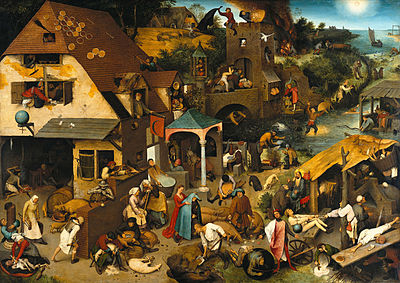Produced in 1559 Pieter Bruegels's Netherlandish Proverbs is a riot of a painting, expressing a dry and witty view of mankind through bringing to life various Netherlandish Proverbs of the day.
In spite of its historical setting it is as relevant today as when it was first painted. Bruegel was living through tumultuous times. He lived in a country under Spanish, Catholic rule, where the shadow of the Spanish inquisition was looming but where religious absolutes were now choices following the reformation. Bruegel's own religious views are unclear - he had humanist patrons and associates, but was not openly opposed to either Catholicism or Protestantism. Netherlandish Proverbs can be read as an exploration of religiosity; it is a godless landscape where the moralistic proverbs allow the viewer to make sense of what is happening.
There are over 110 proverbs referenced, with some parts of the picture referencing two or three proverbs. In addition there are modern markers that Bruegel probably never intended but which reflect how little our society has moved on since Bruegel's times. Set in a rural, largely peasant community, it is madness of a society. Look closely and there are various bottoms doing unspeakable things, a couple of men trying to shear pigs, someone biting a pillar and a roof tiled with pies. It seems superficially to be feeding stereotypes of stupid country yokels - but this is part of the trick of the painting.
In truth the image is scrutinising all of society, but in giving it a rural setting is allowing Bruegel's audience to distance themselves from what they see. The society in front of them looks like an anarchy - everyone is out for themselves - which is a reflection of the proverbs they represent. In this society of one-upmanship getting the advantage over others is more important than living well. Whatever is used to get to the top, whether it be the scarlet woman putting a blue cloak on her cuckolded husband, the pillar biter using religious hypocrisy to put others down, the innkeeper showing they are liable to cheat others by hanging their scissors 'out there', the two-faced woman carrying fire and water or just those whose opinions change direction with the wind hanging their cloak out to see which way it blows, Bruegel isolates their folly and exposes it.
This is what makes Netherlandish Proverbs so relevant still today; technology has advanced, but human beings are still prone to the same idiocy they always have been. In fact, as we shine a brighter light on human behaviour in the modern world, we are actually starting to see even more examples of it than ever before.





